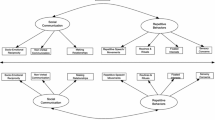Abstract
To examine the external validity of DSM-IV childhood disintegrative disorder (CDD), 10 children (M = 8.2 yrs) with CDD and 152 gender- and age-matched children with autistic disorder (AD) were compared on 24 variables. The CDD children had a significantly higher rate of epilepsy, significantly less uneven intellectual functioning, and a tendency of greater abnormality in auditory responsiveness than AD children, to validate CDD externally. Their short-term outcome, as shown in the degree of retardation, was not worse than the AD children, which is in disagreement with previous studies reporting worse outcomes in CDD than autism. These results need to be verified by a long-term prospective study that compares CDD and AD patients from infancy.
Similar content being viewed by others
References
American Psychiatric Association. (1980). Diagnostic and statistical manual of mental disorders (3rd ed.). Washington, DC: Author.
American Psychiatric Association. (1994). Diagnostic and statistical manual of mental disorders (4th ed.). Washington, DC: Author.
Bailey, A., Le Couteur, A., Gottesman, I., Bolton, P., Simonoff, E., Yuzda, E., & Rutter, M. (1995). Autism as a strongly genetic disorder: Evidence from British twin study. Psychological Medicine, 25, 63-77.
Bartak, L., & Rutter, M. (1976). Differences between mentally retarded and normally intelligent autistic children. Journal of Autism and Childhood Schizophrenia, 6, 109-120.
Bodfish,, J, W., Symons, F. J., Parker, D. E., & Lewis, M. H. (2000). Varieties of repetitive behavior in autism Comparisons to mental retardation. Journal of Autism and Developmental Disorders. 30, 237-243.
Burd, L., Ivey, M., Barth, A., & Kerbeshian, J. (1998). Two males with childhood disintegrative disorder: A prospective 14-year outcome study. Developmental Medicine and Child Neurology, 40, 702-707.
Cantwell, D. P., & Rutter, M. (1994). Classification: Conceptual issues and substantive findings. In M. Rutter, E. Taylor & L. Hersov (Eds.), Child and adolescent psychiatry: Modern approaches (3rd ed., pp. 3-21). Oxford: Blackwell Science.
Chakrabarti, S., & Fombonne, E. (2001). Pervasive developmental disorders in preschool children. JAMA, 285, 3093-3099.
Evans-Jones, L. G. & Rosenbloom, L. (1978). Disintegrative psychosis in childhood. Developmental Medicine and Child Neurology, 20, 462-470.
Heller, T. (1908). Über Dementia infantilis: Verblödungsprozess im Kindesalter. Zeitschrift für die Erforschung und Behandlung des Jugendlichen Schwachsinns, 2, 17-28.
Hill, A. E., & Rosenbloom, L. (1986). Disintegrative psychosis of childhood: Teenage follow-up. Developmental Medicine and Child Neurology, 28, 34-40.
Kurita, H. (1988). The concept and nosology of Heller's syndrome: Review of articles and report of two cases. Japanese Journal of Psychiatry and Neurology, 42, 785-793.
Kurita, H., Kita, M., & Miyake, Y. (1992). A comparative study of development and symptoms among disintegrative psychosis and infantile autism with and without speech loss. Journal of Autism and Developmental Disorders, 22, 175-188.
Kurita, H., Miyake, Y., & Katsuno, K. (1989). Reliability and validity of the childhood autism rating scale—Tokyo version (CARS-TV). Journal of Autism and Developmental Disorders, 19, 389-396.
Kurita, H., Osada, H., Shimizu, K., & Tachimori, H. (2003). Validity of DQ as an estimate of IQ in children with autistic disorder. Psychiatry and Clinical Neurosciences, 57, 233-235.
Lockyer, L., & Rutter, M. (1970). A five-to fifteen-year follow-up study of infantile psychosis. IV. Patterns of cognitive ability. British Journal of Social and Clinical Psychology, 9, 152-163.
Malhotra, S., & Gupta, N. (2002). Childhood disintegrative disorder: Re-examination of the current concept. European Child & Adolescent Psychiatry, 11, 108-114.
Malhotra, S., & Singh, S. P. (1993). Disintegrative psychosis of childhood: An appraisal and case study. Acta Paedopsychiatrica, 56, 37-40.
Mouridsen, S. E., Rich, B., & Isager, T. (1998). Validity of childhood disintegrative psychosis: General findings of a long-term follow-up study. British Journal of Psychiatry, 172, 263-267.
Schopler, E., Reichler, R. J., DeVellis, R. F., & Daly, K. (1980). Toward objective classification of childhood autism: Childhood autism rating scale (CARS). Journal of Autism and Developmental Disorders, 10, 91-103.
Shah, A., & Frith, U. (1983). An islet of ability in autistic children: A research note. Journal of Child Psychology and Psychiatry, 24, 613-620.
Tsumori, M., & Inage, N. (1961). Nyuyoji seishinhattatsu shindanhou: 0 saikara 3 saimade [Developmental diagnosis of infants and young children: From the age of 0 to 3 years]. Tokyo: Dai-Nihon-Tosho.
Tsumori, M., & Isobe, K. (1965). Nyuyoji seishinhattatsu shindanhou: 3 saikara 7 saimade [Developmental diagnosis of infants and young children: From the age of 3 to 7 years]. Tokyo: Dai-Nihon-Tosho.
Volkmar, F. R. (1992). Childhood disintegrative disorder: Issues for DSM-IV. Journal of Autism and Developmental Disorders, 22, 625-642.
Volkmar, F. R., & Cohen, D. J. (1989). Disintegrative disorder or “late onset” autism. Journal of Child Psychology and Psychiatry, 30, 717-724.
Volkmar, F. R., & Rutter, M. (1995). Childhood disintegrative disorder: Results of the DSM-IV autism field trial. Journal of the American Academy of Child and Adolescent Psychiatry, 34, 1092-1095.
World Health Organization. (1977). International classification of diseases 1975 revision (Vol. 1). Geneva: Author.
World Health Organization. (1989). ICD-10 chapter V: Mental and behavioural disorders: Diagnostic criteria for research (April 1989 draft for field trials). Geneva: Author.
World Health Organization. (1993). The ICD-10 classification of mental and behavioural disorders: Diagnostic criteria for research. Geneva: Author.
Author information
Authors and Affiliations
Corresponding author
Rights and permissions
About this article
Cite this article
Kurita, H., Osada, H. & Miyake, Y. External Validity of Childhood Disintegrative Disorder in Comparison with Autistic Disorder. J Autism Dev Disord 34, 355–362 (2004). https://doi.org/10.1023/B:JADD.0000029556.25869.71
Issue Date:
DOI: https://doi.org/10.1023/B:JADD.0000029556.25869.71




